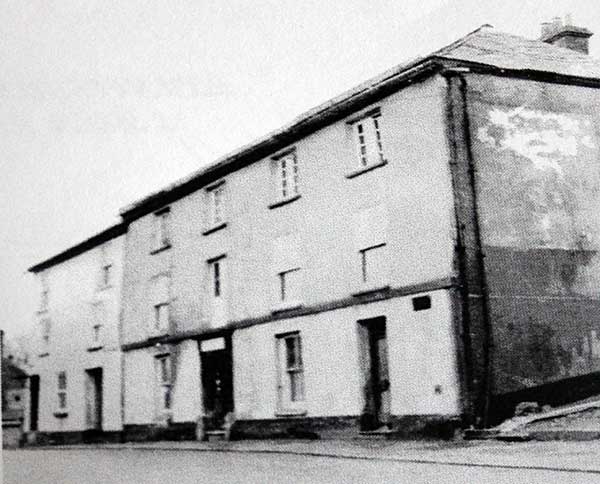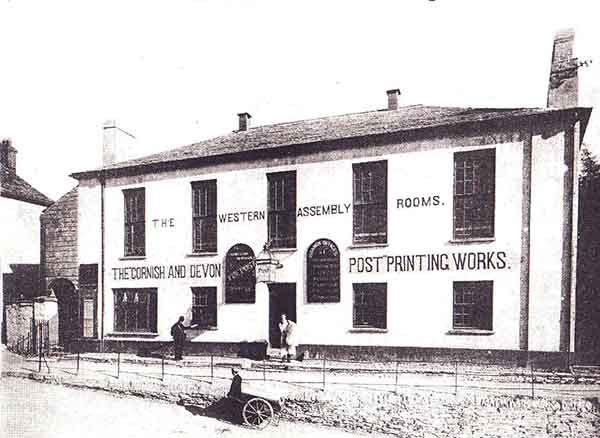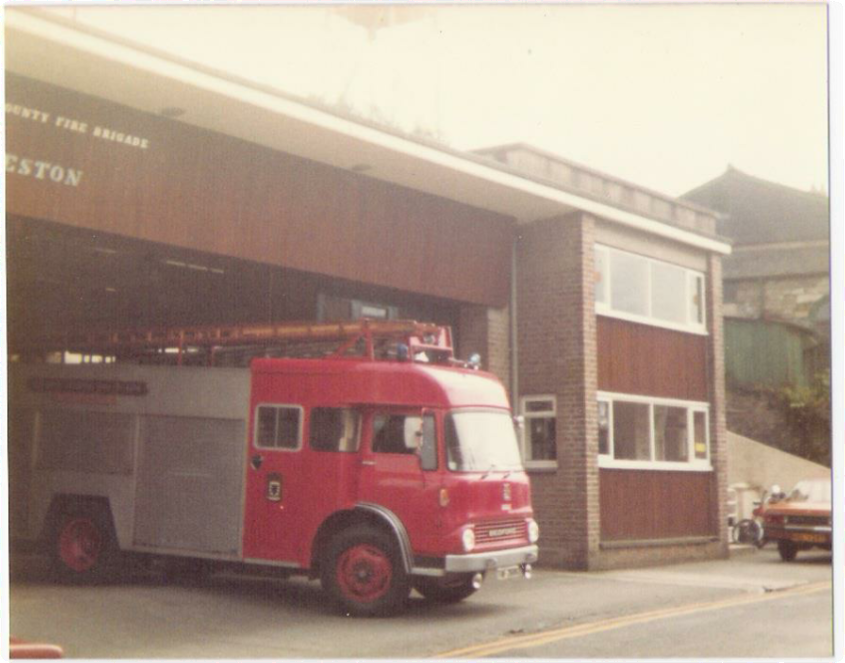.

(Cornish Times, 1883) Letters: History of Launceston, by GMG. Launceston, Jan 4, 1883-
Belle Vue – the former name was Half Moon. An old lady who was born and died here informed me that the house was an inn with that sign, and kept by an ancestor of hers a century or so since. A corroboration of this name appears in the parish rate books not very long since containing the names of some old cottages near, taken down to make room for the approach of the new Dunheved Road. Imagination pictures the horn of His Majesty’s (George II or III as the case may be) mail too-looing on approaching the place, then the only road out of the town towards Bodmin. The coachman pulling up and letting down a tired traveller who was content with a small hostelry wherein to rest and refresh, and preferring it to the more extensive White Hart. – – -(part letter published Sat, January 13th)
The ‘Half Moon’ lay outside the West Gate; in 1740 it was kept by Thomasin Derry, widow of Richard, who had died 10 years earlier. The inventory taken after his death shows him to have been a small farmer and probably a packhorse man:
Purse & wearing apparel £ 1 – 10s Two cows £7.
Five labour horses with their tacking £15. Ten ewes & ten lambs £4. 10s.
One reering sow 15s. Five fether bedds parformed £10.
Pewter, brass & one copper chettle £6. Table bords, chests, chairs,
In cyder & ale £2. boxes, & other limber stuff £1. 15s.
In cash & brewery vessels £1. 2s 6d.
Corne growing & corne in the Mowhay & barn £14.
Wood in ricks, in severall Places & other things & other things unseen & unpraised £2. 5s.
From the above letter it is not clear whether the inn was destroyed or just converted, but it is known that the cottages adjoining the inn at the western end were destroyed in order that the new Dunheved Road could be built. The Dunheved Green reservoir was filled in in 1869 to continue the road to Badash. The building now housing the Cornish & Devon Post is built at an angle, showing that the road junction was by then in place. The building was first called the Western Subscription Rooms wherein ‘Happy Joe’ Maunder earned his sobriquet from the new, and much disparaged Salvation Army. It was used as the town court room, a general meeting room, a dissenter’s meeting place, and a cycle dealer’s shop before being changed for use by the Press.

In June 1800 a number of young men passed their college examinations which entitled them to become preachers of the gospel; at that time each student, at the end of his last term was sent to a chosen place to preach for six weeks before being given a post. One young man was directed to Launceston, of which he had heard, and on being given his orders demurred, saying that he had heard bad things regarding the arguments and unrest at that place. His Tutor said that he was chosen specially because of this as the tutor believed that he was a man of peace and could bring tranquility to this area of unrest..
This young man, Richard Cope, agreed to go for six weeks and arrived in Launceston on 27th June, 1800, and preached his first sermon on Sunday 28th June, at the Congregational Chapel in Castle Street. He was then, in July, requested by the congregation to stay for 12 months, to which he agreed. The Reverend Cope now decided he liked the town so much he decided to remain longer, his congregation had swollen from around 200 to over 600 and he had to enlarge the area of his preaching to the outlying villages. The reverend gentleman took to preaching the gospel at South Petherwin, Truscott, Egloskerry, Yeolmbridge, Langdon, Tamartown, Polyphant, Holsworthy, Lawhitton, Bennacott, Northcot Hamlet, Boyton and Tamerton. He also held services in Callington at the request of the incumbent, the Rev James Messenger. This helped to bring his mind to bear on marriage and in July 1801, Rev Cope decided he could afford a wife and he was wed to Miss Davies, a member of the church in Chapel Street, Soho, London, by the Reverend J Maddy, the curate, in St James’ church, Piccadilly.
Due mainly to his visiting the local villages and preaching there he was now requested by several people to teach their children and to supplement a preacher’s pay he set up a school and took in boarders, his first school being in Westgate Street. As well as townsfolk people like the Rev John Russell of Southill, James Morgan, esq., of Woodovis and Mrs Hooper of Appledore sent their sons to him for their educational training.
After the birth of a daughter in July 1802, his house became too small to accommodate his growing family and the school children and he rented a house in Castle Street from Colonel Lawrence (Lawrence House, since 1964 the Town Museum). The school and family moved in on Monday, 19th December, 1803. Within eleven years his family consisted of five sons and two daughters. (Eldest son Thomas Wilson died in Dublin April 9th, 1822 at the age of 18 years, Emily married Mr James Hiley Morgan of Abergavenny and died February 11th, 1844, aged 41, Edward Leigh died at Launceston September 10th, 1850, aged 44.)
Cope’s happy school soon became too big for Lawrence House and they moved back to Westgate Street around 1813, this time into the newly built Westgate Terrace, built on the site of a rather notorious ‘Lodging House’. The house was formerly the property of Mr Robert Watling who was more celebrated as the several times ‘Mayor of the Pig Market’. According to Mr Richard Robbins, he kept a rendezvous for German musicians, organ grinders and vagrants. He once offered Mr Pattison, landlord of the White Hart Hotel, to share with him some of his lodgers when he was full, and said he would take some of Mr Pattison’s when he could not accommodate them. The pig market was then held at Starcross, on the Square end of Westgate Street, the animals being tied to a ring on the Guildhall wall. There was a custom on Mayor choosing day of appointing a Mayor of the Pig Market; the person chosen for this dignified office would be first made tipsy by liberal amounts of beer and spirits and then proclaimed Mayor. His hat would be torn from his head, which would then be very well powdered with flour, and if his back hair were long enough, a frying pan would be tied to it and allowed to hang down his back. He would then be led away, being merrily pelted with flour by the attending audience, to the New Inn, the house later occupied by the proprietor of the Launceston Weekly News, which had the nickname of the ‘Shindy Arms’. This merry practice was discontinued in 1827.
As his new school rapidly grew Mr Cope was again forced to move to bigger accommodation, this time only next door into Belle Vue House, on the site of which had stood the Half Moon. From among his numerous pupils 16 became ministers of the gospel, several were dissenting ministers and several others became well known personalities. One student becoming The Honorable Thomas Holt, M.P. for Sydney, New South Wales. Two other notables were Sir Joshua Rowe and Sir William Carpenter Rowe, Joshua, born in Torpoint, was Chief Justice of Jamaica from 1832 to 1856, made a CB in 1848, and died in London in 1874: also Mr H.E. Sargent of Polyphant –
Among Dr Cope’s claims to fame is that he is said to have started the first Sunday School in Cornwall; he visited Dartmoor Prison to preach to the prisoners of war held there from America and from Europe and Africa, claiming that on one such visit he preached to 500 American prisoners amongst whom was a nephew of Paul Jones, ‘the celebrated pirate.’
On 28th July, 1815, The Reverend James Cope, brother of Richard, was ordained at Weytown, Dorset.
In 1820, the Reverend Cope’s stay in Launceston came to an end; the following is an extract from the Church Book of Castle Street Chapel, Launceston: June 24th, 1820.- the Rev R Cope, AM., gave in his resignation to this church, having filled the ministerial office over us twenty years as a faithful pastor, during which time the chapel was enlarged three times and the congregation continued to increase! He was made very useful in the conversion of sinners and in building up the church of the living God. He left us to fill a more important station in the church of God as Tutor at an academy in Ireland.
The reverend was sent to the Irish Evangelical College at Dublin.
A notice in the Cornish & Devon Post, dated March 1863:
LAUNCESTON, CORNWALL: To Be Let from Midsummer next.
All that very Commodious House, situate in Castle Street, in the Borough of Launceston, now in the occupation of Mr G. M. Gifford, containing Drawing Room, Dining Room, Breakfast Room, 6 Bedrooms, 3 Atticks, 2 Kitchens, Pantries, Large Closets, Cupboards, and every other convenience.
The Town Water is brought into the bedrooms. There is a small Garden attached, with Stable if required.
For further Particulars, apply to Messrs, Huxham & Son, Land & House agents
Belle Vue House was put up for sale in 1872, while still in the occupation of George Mitchell Gifford who was the joint manager of the Tavistock Bank, agent for the Royal Farmer’s Fire & Life, and Scottish Provincial Life & Fire Insurance companies. George was also a founding member of the Launceston Volunteer Fire Brigade, serving as Secretary for many years.
(The Post & Weekly News): For Sale by Private Contract: Desirable Freehold Property, in the Borough of Launceston. That well-known Residence “BELLEVUE” containing Three sitting and Six bedrooms, Two Kitchens, Cellar and all necessary Outhouses, a Conservatory, Gardens and Shrubbery, upwards of a Quarter Acre in extent (commanding delightful and extensive views, including the ancient Castle, St Stephen’s Village and Downs) the soils of which is of a highly productive quality, courtilage, & C.
ALSO the adjoining House, comprising Three Sitting and Bedrooms, with extensive Drying Lofts over, and to which a small garden is attached.
These Premises are immediately contiguous to the new ‘Dunheved Road’ where villas are now erected and others contemplated, causing a great improvement in the western end of the town, they are well supplied with pump, town, and rain water, and the drains are in connection with the Town Sewerage.
Further particulars may be obtained from Mr J. S. Eyre, Chemist, High Street, Launceston; Mr Gifford, present occupier, as yearly tenant, will show the premises on any day between 11 and 1 o’clock. January 11th, 1872.”
14th March, 1896. TO LET. Belle Vue, Launceston,, late in the occupation F. J. Curtice, Esq, Surveyor of Taxes.
The House contains about thirteen rooms, has a very large garden, wash houses, yards, and every convenience. Suitable for a family, The house is dry and the drains perfect:- Apply to G. H. Strike, Race Hill House, Launceston.
Belle Vue House was taken down in 1957 so that the new Fire Station could be built on the site. In 2001 this fire station was declared unfit for modern fire fighting use, there being no room for training purposes or further equipment and a search was begun for a new site. In 2002 an area at Scarne, opposite Scarne Farm, was selected on a ‘green field’ site. The new station was handed over on Friday, 21 February, 2003, and the equipment and machinery was removed from Westgate Street and the new station declared ‘open for business’ on Wednesday, 26 February. The station in Westgate Street was then demolished in 2003 to make way for the present coach park.

Visits: 181
